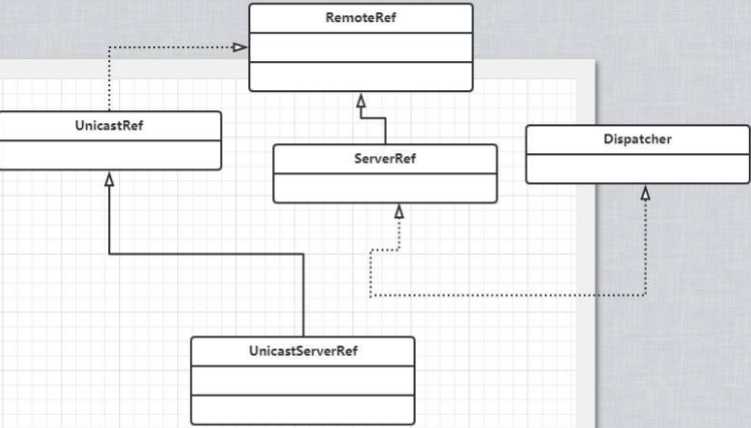标签:gis 网络请求 his 简单 线程等待 als 程序 any 正式
public interface iHelloService extends Remote { String sayHello(String msg) throws RemoteException; }
public class HelloServiceImpl extends UnicastRemoteObject implements iHelloService { protected HelloServiceImpl() throws RemoteException { super(); } @Override public String sayHello(String msg) throws RemoteException { return "Hello" + msg; } }
public class Server { public static void main(String[] args) { try { iHelloService helloService = new HelloServiceImpl();
//创建服务器程序:注册 LocateRegistry.createRegistry(1099); Naming.rebind("rmi://127.0.0.1/Hello", helloService); System.out.println("服务启动成功"); } catch (RemoteException e) { e.printStackTrace(); } catch (MalformedURLException e) { e.printStackTrace(); } } }
public class ClientDemo { public static void main(String[] args) throws RemoteException, NotBoundException, MalformedURLException {
//创建客户端程序 iHelloService helloService = (iHelloService) Naming.lookup("rmi://127.0.0.1/Hello"); System.out.println(helloService.sayHello("MR. White")); } }



发布远程对象
protected UnicastRemoteObject(int port) throws RemoteException { this.port = port; exportObject((Remote) this, port); }
public static Remote exportObject(Remote obj, int port) throws RemoteException { //创建UnicastServerRef对象, 对象内引用了LiveRef(tcp通信) return exportObject(obj, new UnicastServerRef(port)); }
private static Remote exportObject(Remote obj, UnicastServerRef sref) throws RemoteException { // if obj extends UnicastRemoteObject, set its ref. if (obj instanceof UnicastRemoteObject) { ((UnicastRemoteObject) obj).ref = sref; } return sref.exportObject(obj, null, false); }
public Remote exportObject(Remote var1, Object var2, boolean var3) throws RemoteException { Class var4 = var1.getClass(); //创建远程代理类, 该代理是对OperationImpl对象的代理, getClientRef提供的InvocationHandler中提供了TCP连接. Remote var5; try { var5 = Util.createProxy(var4, this.getClientRef(), this.forceStubUse); } catch (IllegalArgumentException var7) { throw new ExportException("remote object implements illegal remote interface", var7); } if (var5 instanceof RemoteStub) { this.setSkeleton(var1); } //包装实际对象, 并将其暴露在TCP端口上, 等待客户端调用 Target var6 = new Target(var1, this, var5, this.ref.getObjID(), var3); this.ref.exportObject(var6); this.hashToMethod_Map = (Map)hashToMethod_Maps.get(var4); return var5; }
public RegistryImpl(final int var1) throws RemoteException { this.bindings = new Hashtable(101); if (var1 == 1099 && System.getSecurityManager() != null) { try { AccessController.doPrivileged(new PrivilegedExceptionAction<Void>() { public Void run() throws RemoteException { LiveRef var1x = new LiveRef(RegistryImpl.id, var1); RegistryImpl.this.setup(new UnicastServerRef(var1x, (var0) -> { return RegistryImpl.registryFilter(var0); })); return null; } }, (AccessControlContext)null, new SocketPermission("localhost:" + var1, "listen,accept")); } catch (PrivilegedActionException var3) { throw (RemoteException)var3.getException(); } } else { LiveRef var2 = new LiveRef(id, var1); this.setup(new UnicastServerRef(var2, RegistryImpl::registryFilter)); } }
private void setup(UnicastServerRef var1) throws RemoteException { this.ref = var1; var1.exportObject(this, (Object)null, true); }
public Remote exportObject(Remote var1, Object var2, boolean var3) throws RemoteException { Class var4 = var1.getClass(); Remote var5; try { var5 = Util.createProxy(var4, this.getClientRef(), this.forceStubUse); } catch (IllegalArgumentException var7) { throw new ExportException("remote object implements illegal remote interface", var7); } if (var5 instanceof RemoteStub) { this.setSkeleton(var1); } Target var6 = new Target(var1, this, var5, this.ref.getObjID(), var3); this.ref.exportObject(var6); this.hashToMethod_Map = (Map)hashToMethod_Maps.get(var4); return var5; }
//TCPEndpoint类中 public void exportObject(Target var1) throws RemoteException { this.transport.exportObject(var1); } //TCPTransport类中 public void exportObject(Target var1) throws RemoteException { synchronized(this) { this.listen(); ++this.exportCount; } boolean var2 = false; boolean var12 = false; try { var12 = true; super.exportObject(var1); var2 = true; var12 = false; } finally { if (var12) { if (!var2) { synchronized(this) { this.decrementExportCount(); } } } } if (!var2) { synchronized(this) { this.decrementExportCount(); } } }
private void listen() throws RemoteException { assert Thread.holdsLock(this); TCPEndpoint var1 = this.getEndpoint(); int var2 = var1.getPort(); if (this.server == null) { if (tcpLog.isLoggable(Log.BRIEF)) { tcpLog.log(Log.BRIEF, "(port " + var2 + ") create server socket"); } try { this.server = var1.newServerSocket(); Thread var3 = (Thread)AccessController.doPrivileged(new NewThreadAction(new TCPTransport.AcceptLoop(this.server), "TCP Accept-" + var2, true)); var3.start(); } catch (BindException var4) { throw new ExportException("Port already in use: " + var2, var4); } catch (IOException var5) { throw new ExportException("Listen failed on port: " + var2, var5); } } else { SecurityManager var6 = System.getSecurityManager(); if (var6 != null) { var6.checkListen(var2); } } }
iHelloService helloService = (iHelloService) Naming.lookup("rmi://127.0.0.1/Hello");
private static Registry getRegistry(ParsedNamingURL parsed) throws RemoteException { return LocateRegistry.getRegistry(parsed.host, parsed.port); } //======================================== public static Registry getRegistry(String host, int port, RMIClientSocketFactory csf) throws RemoteException { Registry registry = null;
//获取仓库地址 if (port <= 0) port = Registry.REGISTRY_PORT; if (host == null || host.length() == 0) { // If host is blank (as returned by "file:" URL in 1.0.2 used in // java.rmi.Naming), try to convert to real local host name so // that the RegistryImpl‘s checkAccess will not fail. try { host = java.net.InetAddress.getLocalHost().getHostAddress(); } catch (Exception e) { // If that failed, at least try "" (localhost) anyway... host = ""; } } LiveRef liveRef = new LiveRef(new ObjID(ObjID.REGISTRY_ID), new TCPEndpoint(host, port, csf, null), false); RemoteRef ref = (csf == null) ? new UnicastRef(liveRef) : new UnicastRef2(liveRef);
//创建远程代理类, 引用liveRef, 好让动态代理时, 能进行tcp通信 return (Registry) Util.createProxy(RegistryImpl.class, ref, false); }
public RemoteCall newCall(RemoteObject var1, Operation[] var2, int var3, long var4) throws RemoteException { clientRefLog.log(Log.BRIEF, "get connection"); Connection var6 = this.ref.getChannel().newConnection(); try { clientRefLog.log(Log.VERBOSE, "create call context"); if (clientCallLog.isLoggable(Log.VERBOSE)) { this.logClientCall(var1, var2[var3]); } StreamRemoteCall var7 = new StreamRemoteCall(var6, this.ref.getObjID(), var3, var4); try { this.marshalCustomCallData(var7.getOutputStream()); } catch (IOException var9) { throw new MarshalException("error marshaling custom call data"); } return var7; } catch (RemoteException var10) { this.ref.getChannel().free(var6, false); throw var10; } }

public void invoke(RemoteCall var1) throws Exception { try { clientRefLog.log(Log.VERBOSE, "execute call"); var1.executeCall(); } catch (RemoteException var3) { clientRefLog.log(Log.BRIEF, "exception: ", var3); this.free(var1, false); throw var3; } catch (Error var4) { clientRefLog.log(Log.BRIEF, "error: ", var4); this.free(var1, false); throw var4; } catch (RuntimeException var5) { clientRefLog.log(Log.BRIEF, "exception: ", var5); this.free(var1, false); throw var5; } catch (Exception var6) { clientRefLog.log(Log.BRIEF, "exception: ", var6); this.free(var1, true); throw var6; } }

标签:gis 网络请求 his 简单 线程等待 als 程序 any 正式
原文地址:https://www.cnblogs.com/binwenhome/p/12936245.html